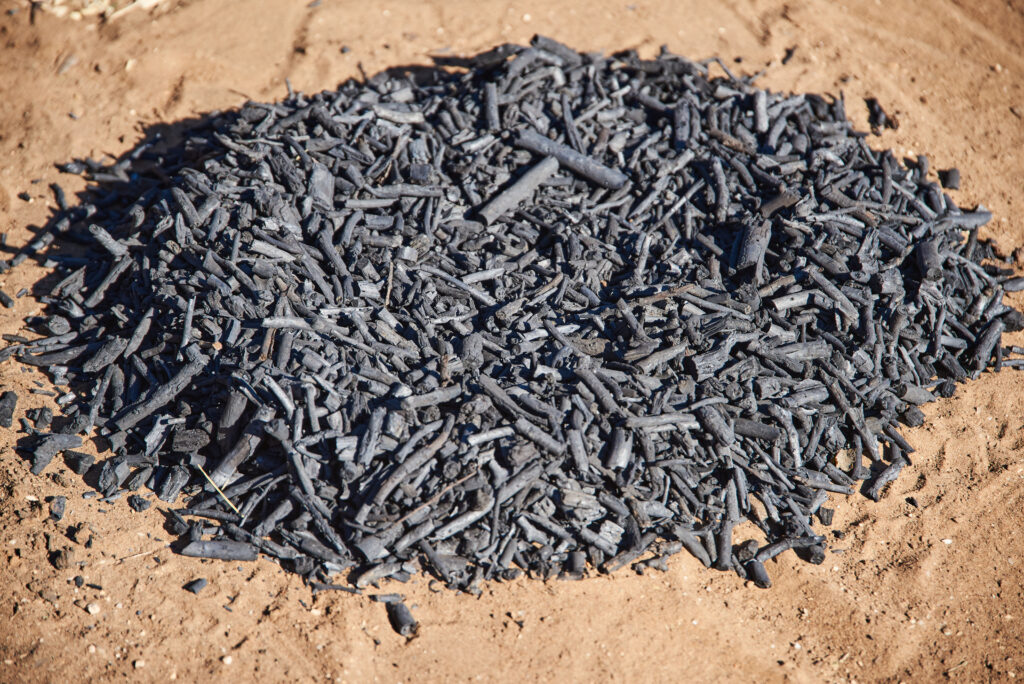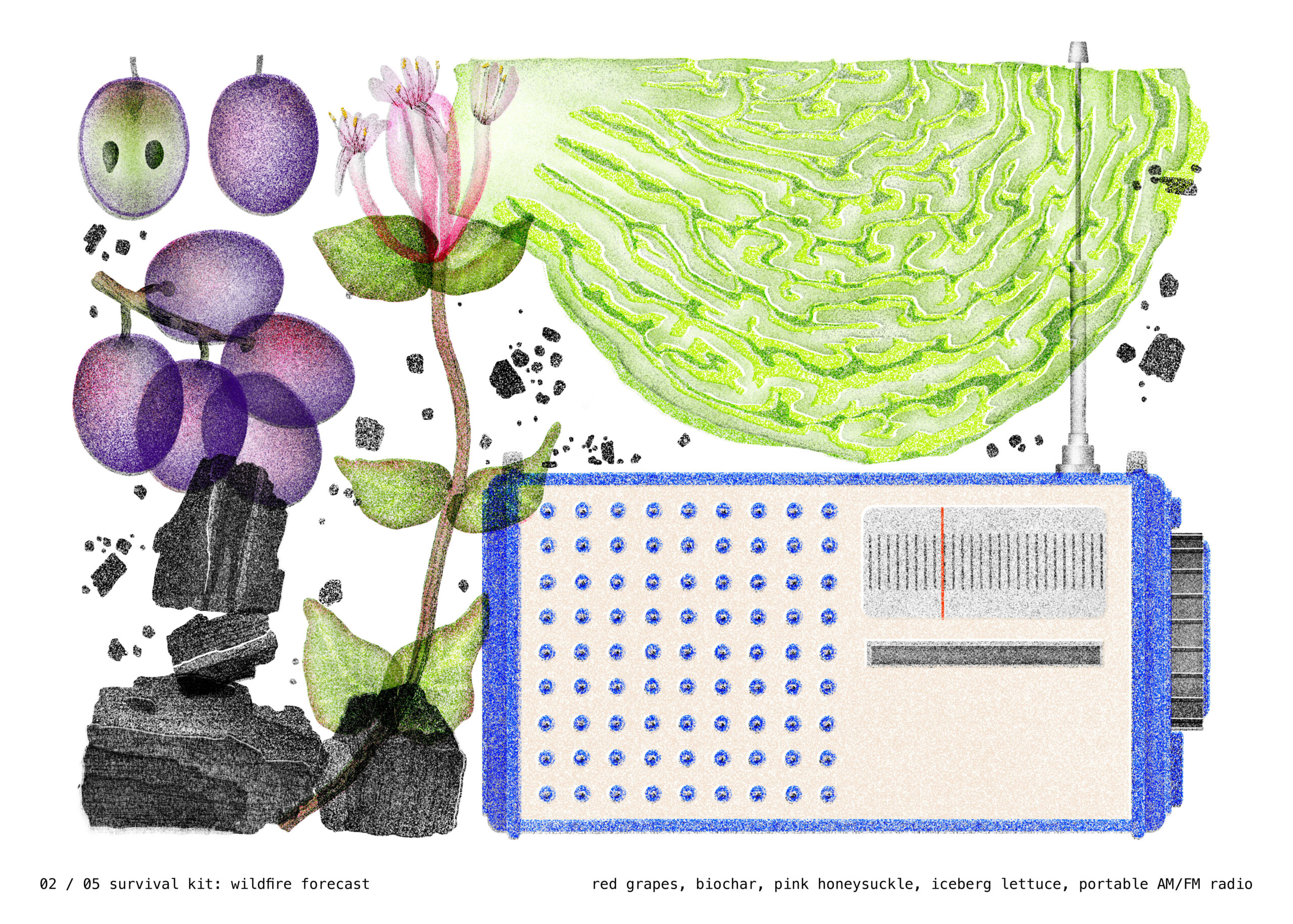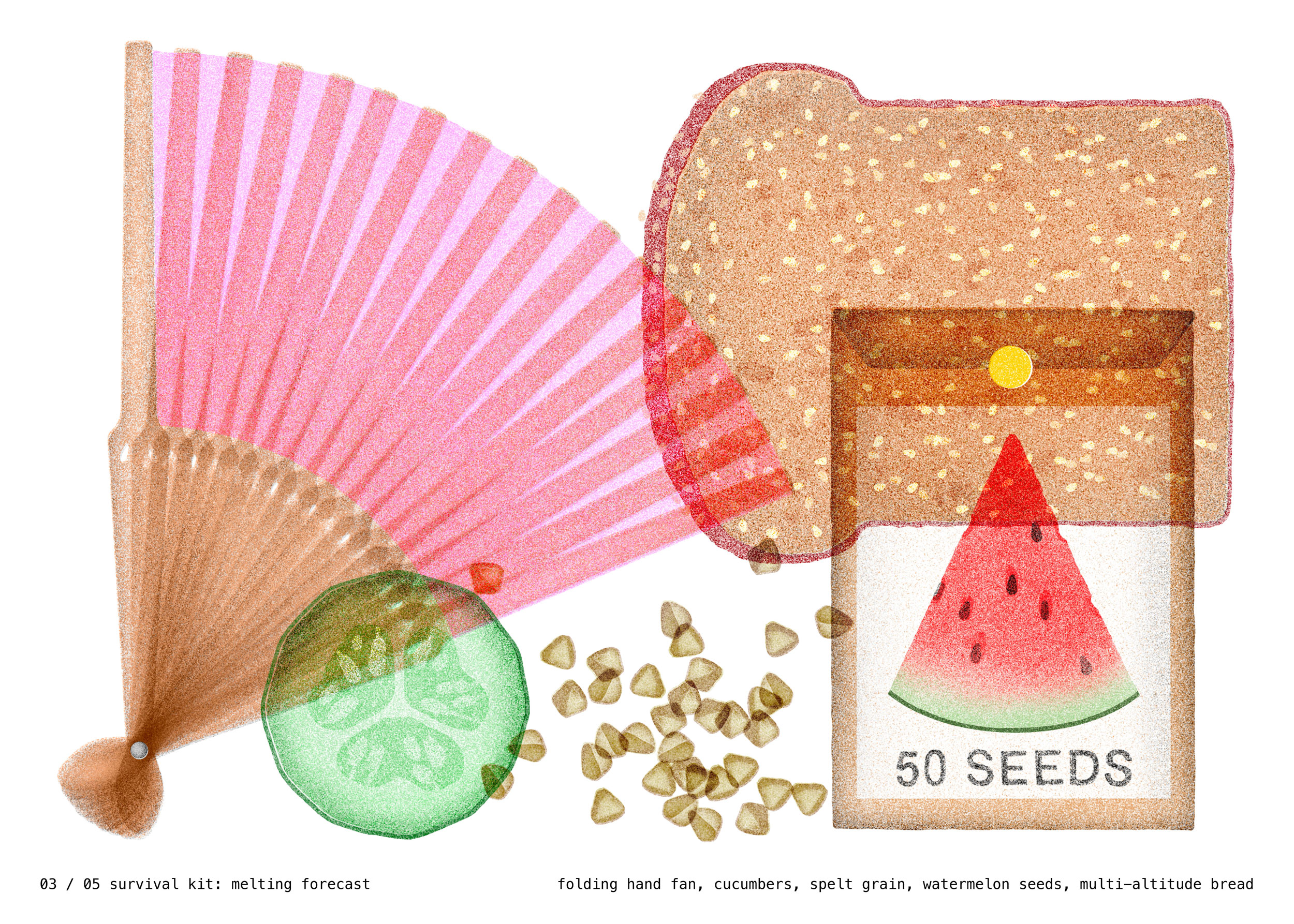Food Forecast is a series exploring the edible plants that will be available in increasingly extreme environments and an exploration of creative strategies to incorporate these plants into our everyday lives. These foods are a glimpse into the way our shifting climate will impact our future diets.
This generation is no stranger to wildfires and the damage they leave behind. There is a paradox: A scorched landscape often contains fertile ground. Like a line of poetry written by fire, or rather a consolation for its destruction, fire’s impact can be as generative as it is dangerous.* Depending on what has burned and how, ash and charcoal left behind by fire can serve as filters, sponges for water, or nutrient-rich carbon sinks. Much of fire’s potential depends on the ways we as humans cultivate our relationship to it. In a conversation with Iain Kerr, professor and member of Spurse Studio, he noted that given the way we have developed and built up the land, “Fire can’t behave otherwise.” But we can. Whether it is firewise landscaping, fire prevention, or farming using biochar to improve soil health, people are working alongside fire in seemingly novel but truly ancient ways.
A few weeks ago hundreds of homes burned in the Valparaiso region of Chile and as I write this wildfires are moving through Zapotec communities in Oaxaca, Mexico. While forests have always had naturally occurring fires, they just haven’t been this large, dangerous, frequent and unpredictable. Rising temperatures, new housing developments, low rainfall, and fuel buildup make the perfect tinderbox. In the last few years fire management planners have finally begun to rethink decades of fire suppression, incorporating indigenous knowledge, such as the California government’s integration of Yurok and Karuk prescribed fires, into mainstream fire planning.
A practice that is often referred to as “good fire”, prescribed burns apply a method of intentionally setting low-severity, controlled fires to select areas and specific plants. A practice of maintenance, “good fire” helps to clear highly flammable fuel from forest floors. This prevents brush from building into megafires, which often burn at such high intensity that they not only eat up entire neighborhoods but have the lasting impact of sterilizing the ground, including the mycorrhizal networks within. Instead, concentrated controlled fire management returns phosphorus and nitrogen to the soil. In order to keep the forest ecosystem alive, these fires need to be localized and small, but they do need to happen.
Rising from a fire’s ashes are two specific categories of plants that have evolved for thousands of years alongside fire, those that withstand and require fire, and those who appear in a fire’s wake. Active pyrophytes are plants that have adapted a tolerance to fire and in some cases, like eucalyptus, oils to fuel it. Pyrophilic plants, on the other hand, are species that depend on fire to release their seeds, which establish once the land is cleared. Sequoias, giants of the forest, often start their lives as a little seed (think the size of a pinenut), popping out of a pod opened in the heat of a fire, able to take root because of the cleared enriched postfire soil. While few of these are edible to humans, many of them provide food and habitats to non-human inhabitants. When prescribed fires burn, they also create clearings for plants that are not fire resistant but need sunlight, such as berries and other edibles, as well as animals like deer and elk emerge to feed in these less wooded areas. These large grazing animals are a form of fire management in themselves.

Herds of sheep and goats are being employed for targeted grazing as a method of vegetation management in wildfire prone areas of California. Michael Leicht, a Type 1 firefighter and owner of Ventura Brush Goats, described how large herds of grazing macro fauna lived on this land for thousands of years prior to freeways and land development. They would eat their way through the forest and prevent fuel load buildup that creates megafires. Like prescribed burns, these teams of goats and sheep provide a modern approach to restoring ancient ecological balances. Rather than staying stationary as is customary in most grazing agriculture, the goats get to eat at what Leicht called a “new salad bar each day”. Another benefit to the land comes from the goats’ pellet manure, which is carbon-rich, much like the ash that follows prescribed fires. Carbon-rich soils not only contribute nutrients to the soil but are a sponge for water and a tool for replenishing groundwater.
A continent away in the soil of the Amazon forest similar nutrients and carbons tell a story 8000 years old of how the first agrarian communities cultivated fire to farm. Terra preta, or black earth— a mix of charred plants, bones, and pottery shards—was used to regenerate and nurture the soils. It is the first record of what is now referred to as biochar, a material that is currently used as an amendment to soil in agriculture, as a tool for sequestering carbon, and as a form of waste management. While it does not have the same purpose or cause as prescribed burns, many of the benefits present in those fires are amplified and controlled when creating biochar with the added benefit of extremely low emissions.

Biochar is a porous charcoal that results from heating (pyrolyzing) organic matter (often waste) in an oxygen scarce kiln, a process referred to as thermochemical decomposition. Permaculture has long incorporated biochar into soils and there are organizations such as the Sachamama Center Association in Peru, which operates mainly as a school for students to learn about biochar, or yana allpa, in agriculture. In conversation with the founder, Frédérique Apffel-Marglin she described the Amazon as a garden full of food due to its rich soils thanks in part to the ancient biochar creating conditions that allow the soil to retain water and nutrients. Besides its traditional use as an amendment to soil, biochar is being touted as a tool to manage waste and sequester carbon. Some studies show that up to 20% of greenhouse gasses can be sequestered by biochar. This has caught the attention of the carbon credit industry in the United States. When speaking with Bella Culotta, the East African Programs Manager for Lehmann Lab at Cornell University, she hoped that the sudden interest and investments in biochar would help the agroecology sector develop. As I asked questions about the potential long-term benefits of biochar to soil, Culotta warned about the oversimplification of soil saying, “Imagine if we said everything from our feet up to the atmosphere was one topic that is what we are doing from our feet down.” It might just look like dirt or charcoal to the untrained eye, but what is happening on a molecular level is still being studied and understood.
Even if the impacts are not all yet scientifically verified, there are clear benefits to its use. As soon as I started talking to people about biochar, I was inundated with anecdotes; people using it in home gardening, adapting it into a material like Carbon Cell that could be used in packaging and construction, the dangers of biochar carbon credits enabling greenwashing, the wonky math of it being a silver bullet that could store carbon, deal with waste, and improve depleted soils. In short, there is a lot of excitement, and investment in its potential.
I anticipate that we will see more biochar used in agriculture throughout this decade as well as studies to analyze its impact. At the same time in areas that are fire prone, such as California, the top food producer in the United States, these fires will translate to a legitimate change in American agriculture and diets. Agriculture will or should start to incorporate some of the plants that burn less easily as a means of keeping farms and farmers safe. This includes edible plants such as buckwheat, yarrow, sage, honeysuckle, and flax-plants that are considered “fire wise” or less flammable. Fire is in our future and we can choose to nurture mindful ways of coexisting as humans and animals have for millennia but it will take farmers, agriculture tech, goats, and indigenous knowledge to do so.
Below is a recipe for “Fire Wise” herbal tea blend:
These are all firewise edible plants that grow well in fireprone areas. Each of these plants have a wide range of traditional medicinal uses. You can either forage them or buy them dried. If you do forage them, be mindful of not overharvesting so that the plants can continue to survive and support pollinators as well as other members of the local ecosystem.
½ cup dried yarrow flowers
½ cup toasted buckwheat seeds
¼ cup dried local sage
¼ cup dried manzanita leaves
¼ cup dried honeysuckle
- Mix all ingredients and store in an air tight glass jar.
- When ready to brew, take 2 tablespoons of the tea and brew for 5 minutes before enjoying.
- Serve alongside buckwheat cookies and prickly pear jam.
* As I write of fire, I pay tribute to Aaron Bushnell’s call for a free Palestine. May his death not be in vain.


